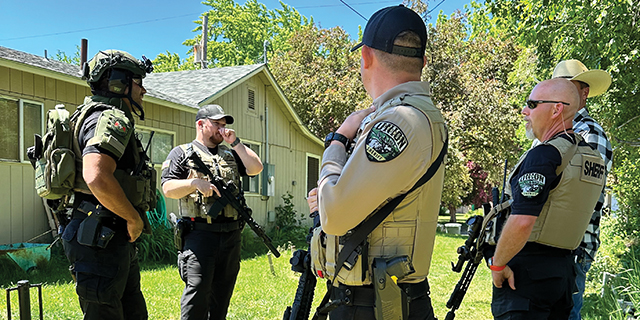On the trail: Finding your way through the fog
Published 2:45 pm Friday, September 3, 2021

- Jayson Jacoby
Hiking through the deep woods on a day when fog is draped across the land, obscuring the tops of the trees, is an inherently eerie experience.
But it’s especially creepy when you’re not familiar with the trail.
Combined with that element of uncertainty, the possibility that the trail’s tread will fade, or make a confounding turn, makes the fog seem slightly sinister, even sentient, and capable of leading you astray.
Fog’s effects are physical as well as psychological.
I’m prone to claustrophobia, and a heavy mist inflames that unpleasant condition. Fog compresses the world, depriving me of the ability to get a sense of my surroundings, cutting into my confidence as a navigator.
This effect might have been strong enough to convince me to turn back while hiking a trail on the west side of the Wallowas on the morning of Aug. 21.
But it was not, and thanks to the good work of the Blue Mountain Back Country Riders, a group of horse riders who maintain dozens of miles of trails in and around the Eagle Cap Wilderness.
It was, as I mentioned, a foggy morning, a decidedly rare situation in summer.
Indeed the day reminded me far more of October than of August. The temperature was 45 when I started walking with my wife, Lisa, and our son, Max, who’s 10. An occasional raindrop splattered off the brim of my cap. I was glad I brought my fleece jacket, a garment I tend to forget about for long stretches of more typical summer weather.
Our route was along the Lodgepole trail, No. 1920.
The path isn’t listed on the Wallowa-Whitman National Forest’s website but it is shown on several maps I own. Its southern end, where we started, is accessed by the Hess Cabin Road, which branches off Highway 203 near Catherine Creek State Park, between the North Fork of Catherine Creek and Little Catherine Creek.
There were no signs to indicate where the trail might start, or whether it might actually exist, come to that.
We hiked north on Road 2038, which is blocked by a tank trap. After a little less than half a mile on this route, which is very clearly an old road due to its width, and just before another tank trap and a fence, we noticed a well-defined trail branching off to the east.
The path climbed relatively steeply, which coincided with the route shown on a topographic map.
We had only hiked a couple hundred feet when it became clear that we were going the right way.
The tread itself was obvious.
But I was more comforted by what I saw, at regular intervals, on both sides of the trail.
Cut logs.
If you manage to temporarily misplace a hiking path — as most backcountry travelers are apt to do on occasion, and especially when fog lays heavy — one reliable way to reacquire it is to look for these smooth wounds left by a crosscut or chain saw.
Like as not, the space between the two cuts is the trail.
I talked on the phone with Dick Walker of Union, a volunteer with Blue Mountain Back Country Riders.
Dick told me the group regularly logs out the Lodgepole trail, which runs for five miles or so to its northern terminus near Moss Springs campground.
I told him I appreciated that.
Especially after hiking part of the trail and seeing the remnants of the volunteers’ good work — dozens of logs that had been sawed through. Had even a quarter of those logs still been spanning the trail, it would have been an exhausting, annoying and, given my predilection for clumsiness, likely painful hike.
We covered just the first two miles or so of the trail, but it was enough to compel me to return on a day when the view extends for more than a few hundred misty feet.
According to a June 1993 document from the Wallowa-Whitman National Forest, the Lodgepole trail, parts of which are inside the Eagle Cap Wilderness, was formally closed to motor vehicles in that month.
The document doesn’t explain why the trail wasn’t previously closed, given that motor vehicles are prohibited in wilderness areas.
The trail climbs for the first quarter mile or so, crossing a couple of small openings that have the characteristic look of the western Wallowas. The most notable part of this wardrobe is the rock — the brown basalt that is so distinct from the white granitic rock, and limestone, that are the predominant formations in most of the range.
Although the Lodgepole trail’s namesake tree is well-represented in the forests through which it passes, my attention was diverted by another, and much less common, conifer.
You won’t often come across mountain hemlocks in Northeastern Oregon. The species, with its distinctive needles, of even length and arranged in a spiral around the twigs, generally grows only in higher-elevation forests where snow lingers long in the spring.
This typically means north- or east-facing slopes. Along the Lodgepole trail we saw hemlocks on those aspects, but also, in a few places, near the top of a ridge that had more of a westerly aspect. This must be a snowy spot. It makes sense that it would be, as this ridge is the first rampart that moisture-laden winter storms slam into as they ride the jet stream from the Pacific across the Northwest, offloading some of their rain and snow on each of the ranges between the Cascades and the Great Plains.
Hemlocks are easy to recognize because their tops droop in a way that no other conifer does, a gentle curve rather like the form of a diver at the apex of a leap.
Hemlocks are not, however, easy to recognize when fog obscures the tops of even juvenile trees.
We had another engagement scheduled so we turned back before I was satisfied, perhaps my commonest complaint on mountain trails.
I inevitably wish to hike just far enough to find out where a climb ends, whether the trail veers into a draw directly or bypasses it by ascending a divide.
This compulsion nags me on clear days, when the prospect of a sweeping view pulls me along, like the mechanical rabbit at a dog-racing track.
I might have predicted that I wouldn’t feel compelled to keep hiking on a foggy day, when visibility was measured in feet rather than in miles.
But this was not so.
If anything, I felt a stronger urge to continue, since the fog prevented me from guessing at where the path might lead even a few hundred feet ahead.
This heightened the sense of anticipation, of mystery, that attends any journey along a route that is unfamiliar.
I rarely need to invent reasons to return to a trail.
As we retraced our steps through the clammy air, weaving between the occasional clump of grass to keep from soaking our shoes, I appreciated that the fog had given me an especially compelling excuse to come back this way on another, brighter day.
To get to the southern end of the Lodgepole trail, drive Highway 203 to between Mileposts 9 and 10 (head south from Union if you’re coming from La Grande or points north, or north from I-84 near Baker City if you’re coming from the south). Turn off Highway 203 onto Forest Road 2036, the Hess Cabin Road, near the highway bridge over Catherine Creek. Follow Road 2036 for six miles to an intersection with Road 2038. Turn right onto Road 2038 and follow it for five miles to a clearing where the road is blocked to the north by a tank trap. Hike the closed road for about 750 yards, to another tank trap, and look for the trail on the right, heading uphill into the trees. There’s no sign but the trail is obvious.





